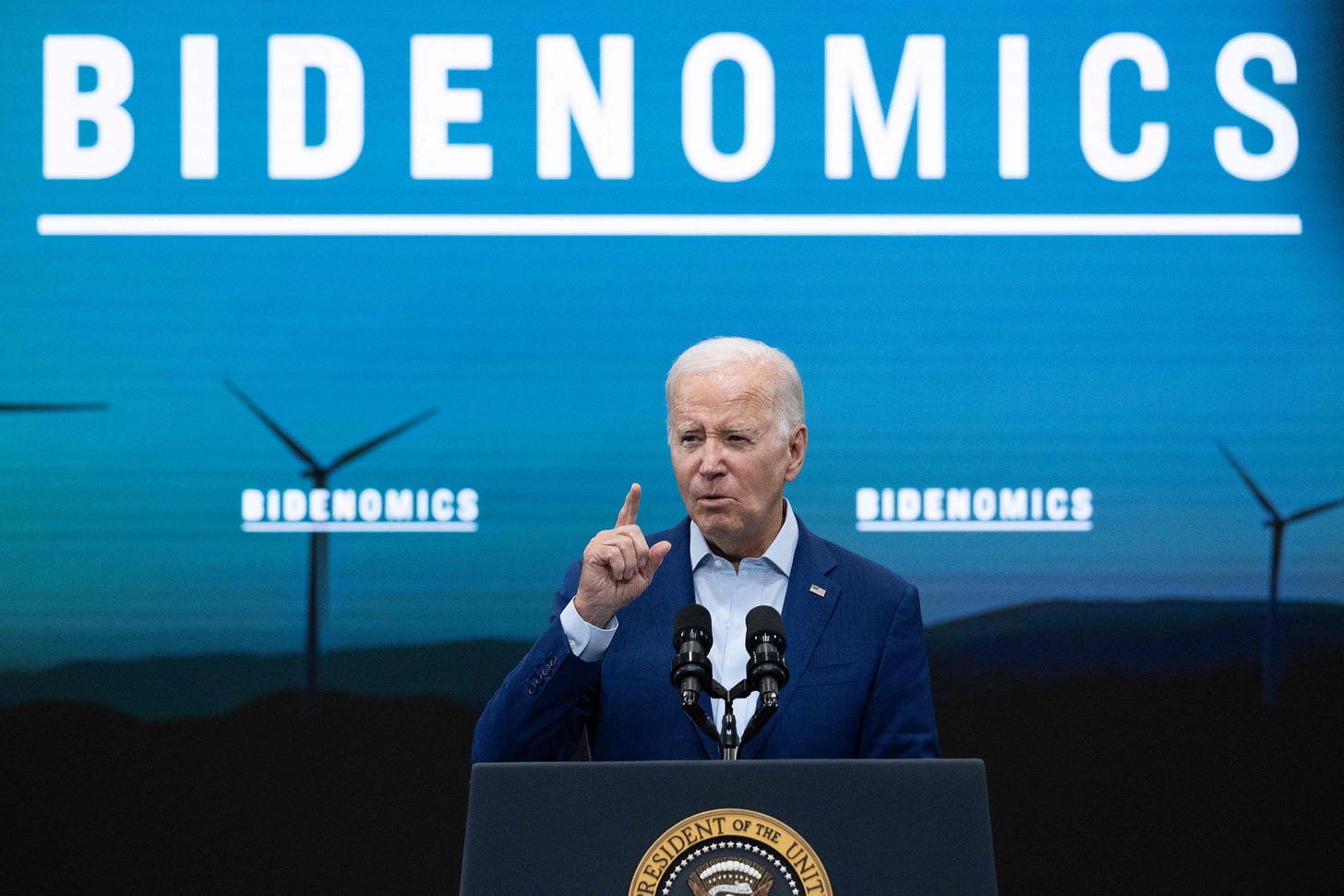
A Climate Action President Presiding Over an Oil and Gas Boom
It’s a complicated political balancing act—and a difficult one to explain to voters.

JOE BIDEN HAS AN UNUSUAL PROBLEM: His energy record is setting records—for both oil and gas and the fight to slow climate change. These milestones are not nearly as well known as they should be, but talking them up carries risks. They appeal to completely different types of voters, and Biden needs them all to win re-election. They could cancel each other out, politically and in their impact on the planet.
The administration routinely calls climate change “the existential threat of our time.” But competing imperatives are still top of mind, especially those that concern the survival of democracy at home and abroad. Russia’s nearly two-year-old invasion of Ukraine and its impact on Europe is one of them. The other is defeating the much indicted, possibly insurrectionist Donald Trump in November.
The American economy must continue to boom if Biden hopes to draw votes from independents, conservatives, and moderates turned off by Trump. The all-time-high oil and gas production could raise Biden’s appeal among them. “It makes Biden appear more capitalist,” as clean-energy consultant Daniel Weiss put it to me. For reality-based voters, it certainly undercuts Trump’s attacks on the “Green New Scam,” his name for a proposed Green New Deal that Biden opposed and that never became law.
At the same time, Biden badly needs to motivate young people, and they are not sold on him. A recent Harvard poll found a dropoff in people under 30 who plan to vote this year compared with 2020. A Tufts University poll that included voters up to age 34 found a higher level of prospective turnout, but also noted that young black people are “less likely” to vote. The economy, climate change, and gun violence were young voters’ top three issues.
Biden has addressed climate, jobs, and economic concerns by investing in emissions reduction, electric vehicle charging networks, power grid improvements, and coastal resilience under the bipartisan 2021 infrastructure law, and spurring manufacturing through tax incentives for clean energy production, electric vehicles, and battery plants in the 2022 Inflation Reduction Act.
But young climate activists are angry at his oil-and-gas accommodations, and even young people who care about climate change can be unaware of his efforts to counter the climate threat—as illustrated by this tweet from Joshua Basseches, an assistant professor of climate and energy policy at Tulane University:
Absent a huge campaign to explain the Inflation Reduction Act, why would they know it? The act was a catchall with a name that utterly failed to convey the scope of its health care, energy, and environmental components. Its $367 billion to fight climate change is “the most ambitious investment in combating the climate crisis in world history,” the Biden administration says. Not U.S. history. World history.
UNDER PRESSURE IN PART from young voters, Biden did make a splashy climate move last month by announcing a temporary pause on permits for liquefied natural gas export facilities and delaying approval for the massive, $10 billion Calcasieu Pass 2 LNG terminal in Louisiana. CP2 would generate 197 million tons of earth-warming emissions each year from the U.S. production process and use of the fuel overseas, former Environmental Protection Agency official Jeremy Symons told the Guardian in October.
He called CP2 “a carbon mega bomb” and added that if several dozen proposed export terminals on the Gulf Coast are built, they’d produce 3.2 billion tons of greenhouse gases a year—“close to the annual emissions of the entire European Union and severely imperiling hopes of avoiding catastrophic global heating.”
The Biden pause, to update permit evaluations with the latest climate science, comes as U.S. natural gas exports are at record highs, America is already the world’s top exporter of liquefied natural gas, and exports are expected to double “by the end of this decade.” And, prudently in a time of two wars and global volatility, there’s a national security escape hatch. The pause is “subject to exception for unanticipated and immediate national security emergencies,” the administration said. Singling out Europe and the possibility of “unprovoked acts of aggression threatening its supply,” the announcement also said the pause would not affect U.S. LNG exports to allies “in the near term.”
If history is any guide, the “pause” won’t end in harmony. The Inflation Reduction Act is a case in point. West Virginia Sen. Joe Manchin agreed to cast his crucial yes vote after striking a side deal to fast-track the much delayed Mountain Valley Pipeline for natural gas. Biden and congressional debt negotiators delivered that deal last year but the pipeline is still incomplete, and protesters from Virginia, West Virginia, and North Carolina are still trying to stop it.
Two consecutive days from March 2023 offer another example of Biden’s precarious tightrope walk on climate. On March 12, he issued an order to protect the entire U.S. Arctic Ocean from future oil and gas leases. And on March 13, he approved the $8 billion Willow project on federal lands in Alaska, clearing the way for drilling up to 199 wells over as long as three decades.
And so it goes. Fox News captured the two-things-can-be-true dynamic in the first paragraph of a story last month: “The White House was silent this week when asked about the increasing levels of crude oil production in the U.S. even as President Biden continues to push an aggressive green energy agenda.”
Biden started his term by reviving what Trump had abandoned—America’s commitments to fighting climate change and to being a global leader in that fight. He created a special presidential envoy for climate, with a seat on the National Security Council; rejoined the global Paris Climate Accord that Trump had quit; re-established the President’s Council of Advisors on Science and Technology; and promised an immediate review of “harmful rollbacks” of pollution standards. Last year, he launched an American Climate Corps to train green energy workers—a nod to the Civilian Conservation Corps created by Franklin Roosevelt—and canceled seven gas and oil drilling leases in the Arctic Refuge that were sold in the final days of the Trump administration.
TRUMP, MEANWHILE, HAS BEEN CAMPAIGNING for early primary-season contests as if it’s 2008 and he’s Sarah Palin. From Council Bluffs to Des Moines, from Durham to Nashua to Las Vegas, it’s “drill, baby, drill,” tossed in a couple of times, sometimes half a dozen times, whatever. It’s a crowd-pleaser, and easy to remember.
How important to Trump is “drill, baby, drill”? So important that as a dictator on Day One, and theoretically for one day only, it’s on his very short agenda. “I want to close the border and I want to drill, drill, drill,” Trump told Sean Hannity at a Fox News town hall in December. In Las Vegas after Biden’s LNG permit pause, he added another Day One task: “I will approve the export terminals on my very first day back.”
In the end it may be Trump himself who tips the scales against himself. But Biden, who has called Trump a “climate arsonist” who engages in “climate denialism,” shouldn’t count on that. He should run on his own record—both the climate part and the energy part. It’s a complicated path in a complicated time, and that’s even more reason to make sure Trump doesn’t get another chance to do it his way.

















